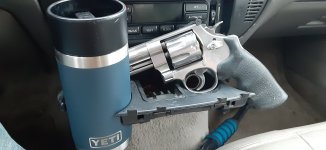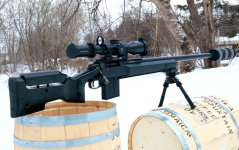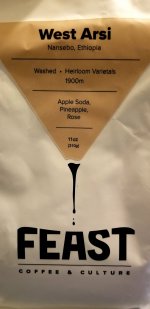My old tried and true Ultra Carry ll.
Join the Hide community
Get access to live stream, lessons, the post exchange, and chat with other snipers.
Register
Download Gravity Ballistics
Get help to accurately calculate and scope your sniper rifle using real shooting data.

Install the app
How to install the app on iOS
Follow along with the video below to see how to install our site as a web app on your home screen.
Note: This feature may not be available in some browsers.
You are using an out of date browser. It may not display this or other websites correctly.
You should upgrade or use an alternative browser.
You should upgrade or use an alternative browser.
Sidearms & Scatterguns Guns and coffee
- Thread starter MJF
- Start date
Scored it from theThat coffee looks familiar.
Good stuff
Some S&W's with coffee.
Kept the original .357 65-3 hammer, bobbed a new replacement and converted to DAO for carry.
Backpacker and Mountain .44 magnums.
I like the Hogue combat grips.


Kept the original .357 65-3 hammer, bobbed a new replacement and converted to DAO for carry.
Backpacker and Mountain .44 magnums.
I like the Hogue combat grips.
The Wisconsin wizard!You got me on that one.
The who? The what?
Wazzat?
Nice! I like seeing the revolvers in this thread.Some S&W's with coffee.
Kept the original .357 65-3 hammer, bobbed a new replacement and converted to DAO for carry.
Backpacker and Mountain .44 magnums.
I like the Hogue combat grips.
View attachment 7787408View attachment 7787409
Steel head, What are those, left to right?
37XC(that I’m starting a build with)
338 Carnie
338 edge
338 Norma
300 Norma
338 grendle aka 338 marmalade
338 Carnie
338 edge
338 Norma
300 Norma
338 grendle aka 338 marmalade
Went to the range this morning to start breaking in my new .45.
View attachment 7764950
Excellent pistola.
How is it running for you ?
My LBC .45's are the most accurate handguns I own.
Coffee & getting out this .45 for a range session tomorrow.

Something just a bit better than normal with this cup of java, however.......... it is extra smoove.
Finally followed through on the tip from @azbiker


Got a deal on this smaller model which will actually be moved to the reloading bench in my mancave.
Thanks for the most excellent suggestion.
These things truly brew a smooth cup and do so very swiftly.
Minimal time farting around waiting on it to brew. I can wake up, fire it up, go let the dogs outside-back inside and it's ready to sip.

Something just a bit better than normal with this cup of java, however.......... it is extra smoove.
Finally followed through on the tip from @azbiker
I had a friend recommend one of these years ago. Did some research and ended up buying one. I bought the thermal carafe model which keeps the coffee hot all day long without heating it after it's brewed. Available multiple places including Amazon.

Moccamaster USA: Premium Pour-Over Coffee Brewers
Coffee brewers handmade in the Netherlands out of high-quality, sustainable materials, built to last a lifetime. Dedicated to seeking the real taste of coffee.us.moccamaster.com


Got a deal on this smaller model which will actually be moved to the reloading bench in my mancave.
Thanks for the most excellent suggestion.
These things truly brew a smooth cup and do so very swiftly.
Minimal time farting around waiting on it to brew. I can wake up, fire it up, go let the dogs outside-back inside and it's ready to sip.
Great! Glad you are enjoying it.Coffee & getting out this .45 for a range session tomorrow.
Something just a bit better than normal with this cup of java, however.......... it is extra smoove.
Finally followed through on the tip from @azbiker
Got a deal on this smaller model which will actually be moved to the reloading bench in my mancave.
Thanks for the most excellent suggestion.
These things truly brew a smooth cup and do so very swiftly.
Minimal time farting around waiting on it to brew. I can wake up, fire it up, go let the dogs outside-back inside and it's ready to sip.
I like the color you chose and your 1911.
Found this orphan.
First year (1983) production, Smith & Wesson N-frame Model 50 / 24-3, new in the box 4" .44 Special, Goncalo Alves (tiger wood) target grips, case-colored hammer-trigger, guarded ejection rod, adjustable rear sight. Gotta love the $5.00 / hr labor charge sheet.


First year (1983) production, Smith & Wesson N-frame Model 50 / 24-3, new in the box 4" .44 Special, Goncalo Alves (tiger wood) target grips, case-colored hammer-trigger, guarded ejection rod, adjustable rear sight. Gotta love the $5.00 / hr labor charge sheet.
New 32” 338 edge barrel from a bartlein blankDetails please. What's being turned out?
I'm going to give some of this Grind Ops a try soon.
Won this brew from a relative who works there. Not bad. Here's a cup for the wife (I drink my coffee "plain") with her carry.

Thinking about one of these Moccamasters; working up some questions for y'all.
Thinking about one of these Moccamasters; working up some questions for y'all.
My favorite coffees are Specialty Grade Ethiopians, prepared using the pour over method. Today's offering: a washed Nansebo Ethiopian.
Pictured is the Jamaican 6gt.
Pictured is the Jamaican 6gt.
Attachments
Last edited:
It was one of my bucket list entriesI wish I could do that.
I keep looking at this pic and saying, "Dayum....lookatdat badassness".Jamaican gt
You don't see these everyday. Franchi SPAS (Sporting Pump Auto Shotgun) 12 with folding stock with the metal "hook" butt stock.
The "Sporting Shotgun" was added to the nomenclature of the shotgun to avoid the notion is was a tactical firearm that was
was prohibited by the 1984 BATF firearm ban; mine shown is one year pre-ban. There are several butt stock variations that were offered, but the metal folding "hook" is the
the desired collectible.
A cult following of the shotgun after being featured in the movie "The Terminator" with Schwartznegger. It took 10 years but I finally cobbled together all the possible accessories for the shotgun. The pump mode was desirable to shoot riot soft rubber rounds. It had a recall for the original lever safety which could fire the round when taking "off" the safety; a factory recall involved cross-bolt safety replace the lever style. One of the interesting "accessories" was a 2-piece "muzzle diverter" that screws on to the end of the threaded barrel and transforms the shot pattern into
a lateral (horizontal) pattern for a higher probability of humanoid target hit; purchased it new from the Spas12.com site for $1300 last year, a few years ago I paused @ $500 bucks, bad idea! in retrospect. This one shown has about one box of shells thru it. I authored a technical manual on the lever v. cross bolt safety mechanisms just for fun. It is a very clumsy shotgun to manipulate and I would never consider picking it up for self-defense.
A little mind-numbing back story on the "muzzle device" historical development.
A variety of shotgun muzzle devices have been tried over the years to enhance their effectiveness in a defensive role. One item that comes off often is "Duck Bill Spreaders" most seem to originate in the early 70's. Crane Lake is often cited as were their origin and cited has being used by the SEAL's in Vietnam and by the Air Force Security Forces.
In each case they are cited as being regulated for use with #4 buck shot. Relative reference manuals from the early 70's reveals #4 buckshot was the preferred load for LE-military shotguns.
Crane Lake is often cited as such prototype muzzle devices used by the SEAL's in Vietnam and the Air Force Security Forces.
A&W muzzle in "The Police Shotgun Manual", by Roger H. Robinson, 1973. Mr. Robinson includes many high speed photos that were provided by A&W Engineering of shot loads coming out of the A&W duck-bill device; photos show the diverter to be very efficient at pattern modification
At 10 yards a 7 1/2" H x 29" W pattern with #4
At 30 yards a 25" H x 96" W pattern with #4.
A claimed a 22% reduction in recoil an diminish the muzzle flash to that of a .38 special at night.
A slug can be used as well, imparting two grooves on either side of the slug with a reduction in projectile yaw.
According to Swearengen in _The World's Fighting Shotguns, the US Air Force Directorate of Security Police in the mid-1960s developed a requirement for a spreader choke that would produce a wide elliptical shot pattern. This horizontal pattern spread was supposed to increase the hit probability from a shotgun on a moving target.
The Air Force request went to Frankford Arsenal for action, at the time Frankford was working on improvements to the military shotgun in general. Early experiments at producing a spreader choke were less than successful- the chokes split, patterned poorly and in various ways failed to produce te desired result. Ultimately Frankford ordnance engineer Charles A Greenwood developed the duckbill choke in answer to the Air Force requirement. It was subjected to a good deal of laboratory and field testing.
The original duckbill choke was simply a sleeve with a long V-notch cut on either side, the apex of the V toward the rear. The top and bottom of the sleeve were compressed toward the center line at the muzzle, constricting the emerging pattern of shot in the vertical plane and forcing it to spread horizontally. The sleeve was permanently brazed onto the barrel so that it would not be blown off or rotated by firing the gun.
Early examples of duckbill- equipped shotguns were deployed to Vietnam in the hands of Marines and Navy SEALs. It was found that the open V- notches in the muzzle of the duckbill hung up badly on vegetation as the shotgunner tried to move through thick growth, so the duckbill was modified with a ring around its muzzle to exclude vines and branches. It was discovered that the spreader device worked as advertised, but in reality what was needed in a fighting shotgun was a way of producing dense, lethal patterns.
Spreaders in field testing produced patterns five feet high and twelve feet wide at 30 meters with #4 buckshot loads. At 40 meters, patterns were six feet high and sixteen feet wide. At 40 meters an average sized man would only be hit by a couple of pellets. But with a standard cylinder bored barrel shooting approximately a four- foot circular pattern at 40 meters, some 60% of the shot would strike an average man- sized target.
Still, the duckbill choke had its adherents, among SEALS especially. Development on the idea continued for several years. Clifford Ashbrook and Wilson Wing of Kexplore, Inc. in Houston, TX developed the A&W Diverter in the late 1960s using mathematical concepts, and received patent protection (# 3,492,750) in February 1970.
The HK 512 gas operated 7+1 shotgun, it was manufactured by Franchi for HK under a contract to supply an elite force in Germany (GSG9), i.e. the "Anti-Terrorist Shotgun" . A production over run of 270 units which were imported into the US, employing a shot diverter that creates a rectangular spread .
.









The "Sporting Shotgun" was added to the nomenclature of the shotgun to avoid the notion is was a tactical firearm that was
was prohibited by the 1984 BATF firearm ban; mine shown is one year pre-ban. There are several butt stock variations that were offered, but the metal folding "hook" is the
the desired collectible.
A cult following of the shotgun after being featured in the movie "The Terminator" with Schwartznegger. It took 10 years but I finally cobbled together all the possible accessories for the shotgun. The pump mode was desirable to shoot riot soft rubber rounds. It had a recall for the original lever safety which could fire the round when taking "off" the safety; a factory recall involved cross-bolt safety replace the lever style. One of the interesting "accessories" was a 2-piece "muzzle diverter" that screws on to the end of the threaded barrel and transforms the shot pattern into
a lateral (horizontal) pattern for a higher probability of humanoid target hit; purchased it new from the Spas12.com site for $1300 last year, a few years ago I paused @ $500 bucks, bad idea! in retrospect. This one shown has about one box of shells thru it. I authored a technical manual on the lever v. cross bolt safety mechanisms just for fun. It is a very clumsy shotgun to manipulate and I would never consider picking it up for self-defense.
A little mind-numbing back story on the "muzzle device" historical development.
A variety of shotgun muzzle devices have been tried over the years to enhance their effectiveness in a defensive role. One item that comes off often is "Duck Bill Spreaders" most seem to originate in the early 70's. Crane Lake is often cited as were their origin and cited has being used by the SEAL's in Vietnam and by the Air Force Security Forces.
In each case they are cited as being regulated for use with #4 buck shot. Relative reference manuals from the early 70's reveals #4 buckshot was the preferred load for LE-military shotguns.
Crane Lake is often cited as such prototype muzzle devices used by the SEAL's in Vietnam and the Air Force Security Forces.
A&W muzzle in "The Police Shotgun Manual", by Roger H. Robinson, 1973. Mr. Robinson includes many high speed photos that were provided by A&W Engineering of shot loads coming out of the A&W duck-bill device; photos show the diverter to be very efficient at pattern modification
At 10 yards a 7 1/2" H x 29" W pattern with #4
At 30 yards a 25" H x 96" W pattern with #4.
A claimed a 22% reduction in recoil an diminish the muzzle flash to that of a .38 special at night.
A slug can be used as well, imparting two grooves on either side of the slug with a reduction in projectile yaw.
According to Swearengen in _The World's Fighting Shotguns, the US Air Force Directorate of Security Police in the mid-1960s developed a requirement for a spreader choke that would produce a wide elliptical shot pattern. This horizontal pattern spread was supposed to increase the hit probability from a shotgun on a moving target.
The Air Force request went to Frankford Arsenal for action, at the time Frankford was working on improvements to the military shotgun in general. Early experiments at producing a spreader choke were less than successful- the chokes split, patterned poorly and in various ways failed to produce te desired result. Ultimately Frankford ordnance engineer Charles A Greenwood developed the duckbill choke in answer to the Air Force requirement. It was subjected to a good deal of laboratory and field testing.
The original duckbill choke was simply a sleeve with a long V-notch cut on either side, the apex of the V toward the rear. The top and bottom of the sleeve were compressed toward the center line at the muzzle, constricting the emerging pattern of shot in the vertical plane and forcing it to spread horizontally. The sleeve was permanently brazed onto the barrel so that it would not be blown off or rotated by firing the gun.
Early examples of duckbill- equipped shotguns were deployed to Vietnam in the hands of Marines and Navy SEALs. It was found that the open V- notches in the muzzle of the duckbill hung up badly on vegetation as the shotgunner tried to move through thick growth, so the duckbill was modified with a ring around its muzzle to exclude vines and branches. It was discovered that the spreader device worked as advertised, but in reality what was needed in a fighting shotgun was a way of producing dense, lethal patterns.
Spreaders in field testing produced patterns five feet high and twelve feet wide at 30 meters with #4 buckshot loads. At 40 meters, patterns were six feet high and sixteen feet wide. At 40 meters an average sized man would only be hit by a couple of pellets. But with a standard cylinder bored barrel shooting approximately a four- foot circular pattern at 40 meters, some 60% of the shot would strike an average man- sized target.
Still, the duckbill choke had its adherents, among SEALS especially. Development on the idea continued for several years. Clifford Ashbrook and Wilson Wing of Kexplore, Inc. in Houston, TX developed the A&W Diverter in the late 1960s using mathematical concepts, and received patent protection (# 3,492,750) in February 1970.
The HK 512 gas operated 7+1 shotgun, it was manufactured by Franchi for HK under a contract to supply an elite force in Germany (GSG9), i.e. the "Anti-Terrorist Shotgun" . A production over run of 270 units which were imported into the US, employing a shot diverter that creates a rectangular spread .
.
Last edited:
I love that coffee pot. We had one at deer camp, it made the best coffee!Pistol and bacon all I got right now....
View attachment 7492183
Coffee is still perking....
View attachment 7492184
Mike
1968 27-2 3.5"
There's definitely something very special about the older Smith's....

There's definitely something very special about the older Smith's....
I love that coffee pot. We had one at deer camp, it made the best coffee!
Mike
Still available as antiques on Ebay.........This one was my wifes Grandmothers.
Gave up the keurig, started with a simple small French press this morning.

.......Needs coffee!
Found this like-new 1988-89 S&W M29-4, round butt, case colored 3" highly polished
blue unfluted cylinder to be the stable mate for my 629-Backpacker.
S&W used both a Pachmayr and Hogue grip on this model, 5:1 mfg with the Pachmayr "Presentation" grip style.
The same Pachymayr grip was designed for the K frames, but it apparently fit good-enough to mount it on their N frames.
It's handsome. I have the Hogue combat grip to mount.






Found this like-new 1988-89 S&W M29-4, round butt, case colored 3" highly polished
blue unfluted cylinder to be the stable mate for my 629-Backpacker.
S&W used both a Pachmayr and Hogue grip on this model, 5:1 mfg with the Pachmayr "Presentation" grip style.
The same Pachymayr grip was designed for the K frames, but it apparently fit good-enough to mount it on their N frames.
It's handsome. I have the Hogue combat grip to mount.
Similar threads
- Replies
- 4
- Views
- 270
- Replies
- 0
- Views
- 1K
Precision Rifle Gear
Chronograph Testing: Gun Mount vs. Static
- Replies
- 7
- Views
- 786
- Replies
- 13
- Views
- 1K










